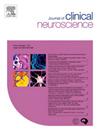高级别胶质瘤的结构和功能连接组学分析:一项系统综述
IF 1.8
4区 医学
Q3 CLINICAL NEUROLOGY
引用次数: 0
摘要
高级别胶质瘤(high -grade glioma, HGG)是一种高度侵袭性和增殖性的脑癌。治疗通常包括最大限度的安全切除,其次是辅助化疗和放疗。然而,对HGG对脑连通性影响的不完全了解限制了对HGG切除后并发症和切除范围方案的预测。以前的工作主要集中在分析临床和结构数据,以了解和预测手术后的结果。这些模型忽略了连接组学——一个专注于大脑神经网络功能映射的新兴领域。在这篇系统综述中,作者1)从功能和结构的角度总结了目前对HGG切除术影响的主要神经网络的理解,2)讨论了基于连接组学的机器学习模型的相关进展及其在预测术后结果方面的应用。方法根据PRISMA指南系统检索2023年10月19日之前的同行评议论文。没有对出版日期加以限制。搜索词包括“连接组学”和“神经胶质瘤”。如果分析了涉及HGG影响的白质束的DTI结构数据和/或rs-fMRI功能数据,则文章被纳入综述。如果结果不适用于hgg,不包括肿瘤位置,或无法获得全文副本,则排除文章。结果我们回顾了41项研究,分析了hgg对脑连接组的影响。hgg倾向于增加富俱乐部淋巴结的结构连通性(SC),降低周围淋巴结的SC,尽管对功能连通性(FC)的影响往往因肿瘤位置而异。正面HGGs引起双侧FC变化,包括全局效率(GE)、局部效率(LE)、度中心性降低和平均路径长度增加。同样,颞叶hgg通常导致双侧FC改变,包括LE降低,GE和小世界特性保留。除了观察到双侧FC的默认模式网络(DMN)变化和楔前叶HGGs变化外,顶叶HGGs主要具有局部效应和保留的小世界组织。岛上的hgg也主要影响局部FC。在应用中,包括FC、LE和GE在内的连接组指标与临床和结构指标相结合,提高了对hgg切除术后并发症的预测能力。结论shgg对不同肿瘤部位的功能连接组有不同的影响。一般来说,hgg倾向于降低远端、半球间FC和LE,而GE和聚类系数保持不变。在应用中,这些指标已用于基于连接组学的模型,以比以前的临床或结构为基础的模型更准确地预测hgg切除术后的并发症。本文章由计算机程序翻译,如有差异,请以英文原文为准。

Structural and functional connectomic analysis of high-grade gliomas: A systematic review
Introduction
High-grade glioma (HGG) is a highly aggressive and proliferative brain cancer. Treatment most often involves maximum safe resection, followed by adjuvant chemotherapy and radiation. However, an incomplete understanding of HGG’s impact on brain connectivity limits the prediction of post-HGG resection complications and extent-of-resection protocols. Previous work has primarily focused on analyzing clinical and structural data to understand and predict post-surgical outcomes. These models overlook connectomics – an emerging field focused on the functional mapping of brain neural networks. In this systematic review, the authors 1) summarize the current understanding of major neural networks impacted by HGG resection through both a functional and structural viewpoint, and 2) discuss associated advancements in connectomics-based machine-learning models and application towards predicting post-surgical outcomes.
Methods
A systematic search was performed of peer-reviewed articles before 10/19/2023 according to PRISMA guidelines. No restrictions on publication date were utilized. Search terms included, “connectomics,” and “glioma.” Articles were included in the review if DTI structural data and/or rs-fMRI functional data involving white matter tracts impacted by HGG were analyzed. Articles were excluded if results did not apply to HGGs, tumor location was not included, or a full-text copy was unavailable.
Results
We reviewed 41 studies which analyzed the impact of HGGs on the brain connectome. HGGs tend to increase structural connectivity (SC) among rich-club nodes and reduce SC among peripheral nodes, though effects on functional connectivity (FC) tend to vary by tumor location. Frontal HGGs elicit bilateral FC changes, including decreased global efficiency (GE), local efficiency (LE), degree centrality, and increased average path length. Similarly, temporal HGGs often result in altered bilateral FC, including decreased LE with preserved GE and small-world properties. Parietal HGGs have mainly local effects and preserved small world organization, apart from observed bilateral FC changes of the default-mode network (DMN) and with precuneus HGGs. Insular HGGs also primarily affect local FC. In application, connectomic metrics including FC, LE, and GE have improved the predictive capabilities of post-HGG resection complications when combined with clinical and structural metrics.
Conclusions
HGG has distinct impacts on the functional connectome based on tumor location. In general, HGGs tend to decrease long-distance, interhemispheric FC and LE while GE and clustering coefficient are preserved. In application, these metrics have been used in connectomic-based models to predict post-HGG resection complications more accurately than previous clinical- or structural-based models.
求助全文
通过发布文献求助,成功后即可免费获取论文全文。
去求助
来源期刊

Journal of Clinical Neuroscience
医学-临床神经学
CiteScore
4.50
自引率
0.00%
发文量
402
审稿时长
40 days
期刊介绍:
This International journal, Journal of Clinical Neuroscience, publishes articles on clinical neurosurgery and neurology and the related neurosciences such as neuro-pathology, neuro-radiology, neuro-ophthalmology and neuro-physiology.
The journal has a broad International perspective, and emphasises the advances occurring in Asia, the Pacific Rim region, Europe and North America. The Journal acts as a focus for publication of major clinical and laboratory research, as well as publishing solicited manuscripts on specific subjects from experts, case reports and other information of interest to clinicians working in the clinical neurosciences.
 求助内容:
求助内容: 应助结果提醒方式:
应助结果提醒方式:


